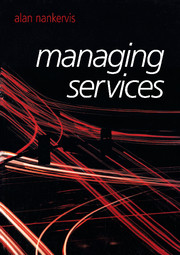Book contents
- Frontmatter
- Contents
- Figures and tables
- Contributors
- Preface
- Acknowledgements
- 1 Services and their management
- 2 The services environment
- 3 Stakeholders and their influence on services
- 4 Managing strategy in services
- 5 Marketing management in services
- 6 Strategic operations management in services
- 7 Financial management in services
- 8 Human resource management in services
- 9 From managing ‘service’ to integrated services management
- Index
- References
1 - Services and their management
Published online by Cambridge University Press: 22 September 2009
- Frontmatter
- Contents
- Figures and tables
- Contributors
- Preface
- Acknowledgements
- 1 Services and their management
- 2 The services environment
- 3 Stakeholders and their influence on services
- 4 Managing strategy in services
- 5 Marketing management in services
- 6 Strategic operations management in services
- 7 Financial management in services
- 8 Human resource management in services
- 9 From managing ‘service’ to integrated services management
- Index
- References
Summary
Learning objectives
After studying this chapter, readers will be able to:
discuss the overall global significance of services
explain the concept, nature and structure of services
understand management concepts and theories
discuss the main issues associated with the strategic management of services.
Introduction
There are many texts that focus on the strategies, plans and operational functions associated with the management of particular industries and organisations. Others explore the application of management concepts in industry sectors such as agriculture and manufacturing, or analyse services from operational or marketing perspectives. However, few books have attempted to examine global services from a strategic management perspective, which combines all management functions within an integrated approach. The reasons for this neglect reflect the complex nature of services, their unclear boundaries and shifting structures, their ‘intangible’ outputs, the perceived social and economic significance of services, and their inherent resistance to the direct transfer of manufacturing models of management.
However, services can no longer be ignored, nor their proper management responsibilities be abrogated, due to their primacy in the economies of all developed, and most developing, countries in the world. It is apparent that there is a need for the development of a strategic management approach for this important sector of the global economy. Services have now supplanted both the primary (agriculture, mining) and the secondary (manufacturing) economic sectors, as a predominant tertiary sector.
- Type
- Chapter
- Information
- Managing Services , pp. 1 - 34Publisher: Cambridge University PressPrint publication year: 2005



